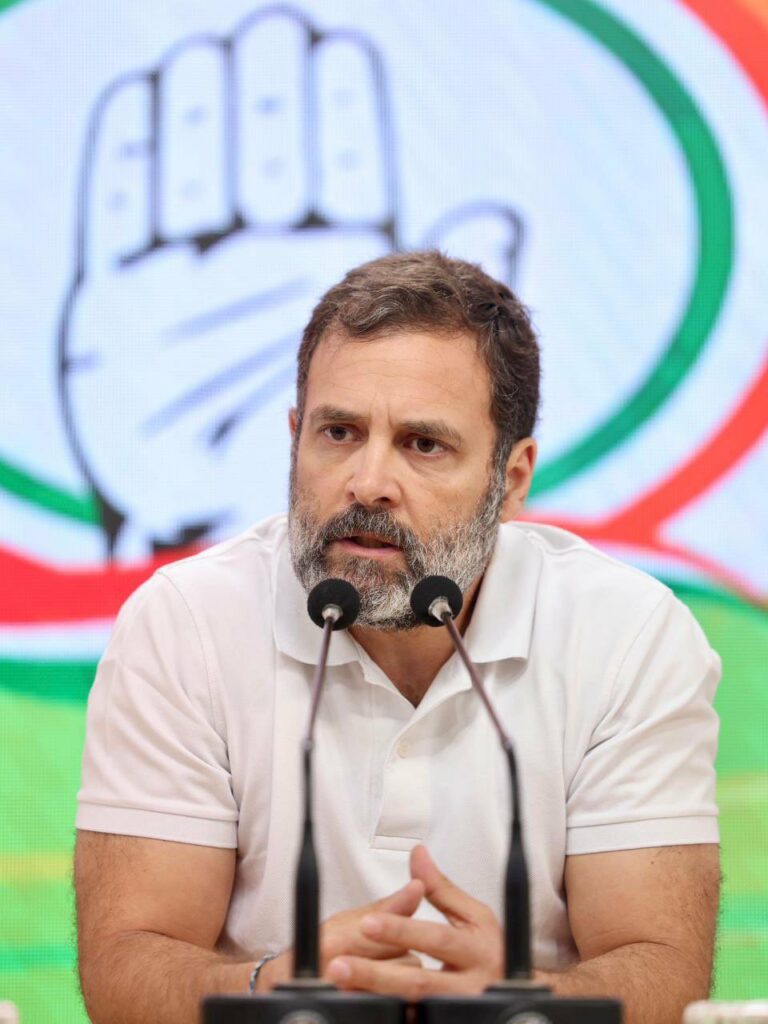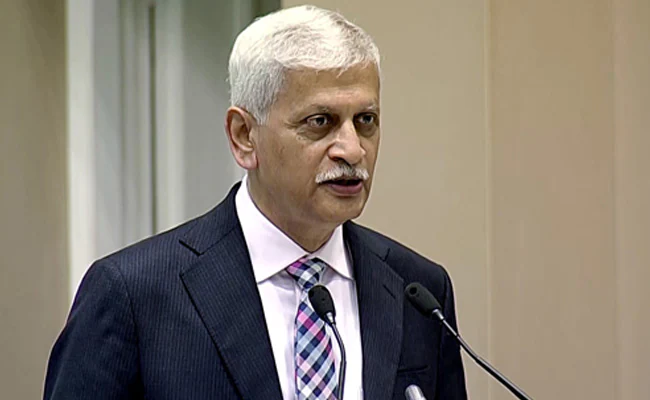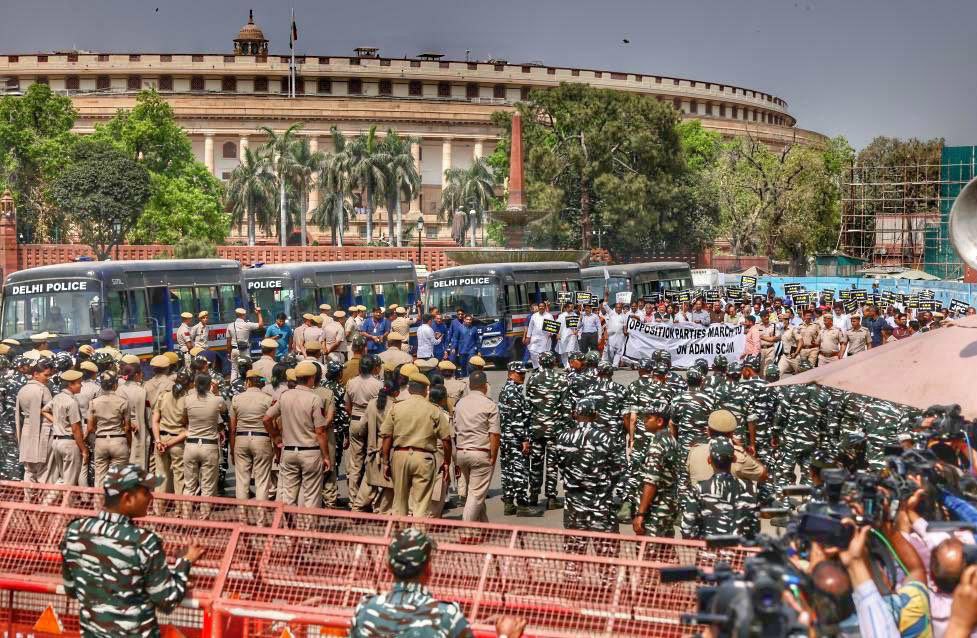Section 144 of Criminal Procedure Code,1973, is most frequently used section of the code. Generally, it is used to prevent any public disorder of law, riot, affray or community clash. From the time of its inception, the section has been highly used as a tool to stop citizens to exercise their rights given under constitution. In recent times, due to some incidents, the misuse of the power given under this section, has been criticized by people.
Some days back, the opposition parties couldn’t march to ED office from parliament, due to enforcement of section 144 on that area. The Mashal March of Indian National Congress against the disqualification of its leader Rahul Gandhi, was also crushed down brutally by the police, and the march couldn’t move further due to imposition of section 144.

Speaking on the launch of a report titled, ‘the use of misuse of section 144CrPC: An Empirical Analysis of all the Orders Passed’, former CJI UU Lalit expressed his concern over excessive misuse of this section by the Delhi police.
The report reveals that emergency powers under Section 144 were exercised by the Delhi police as many as 6,100 times in 2021.

Justice Lalit said, “The purpose of invoking it may be laudable, but where it is invoked in this fashion, it indicates the means to the end do not matter at all because the end itself is thought to be of such sterling quality. To condone this would be to confer on executives, who may be police officers, drastic powers. This kind of power in a country governed by rule of law and democracy is not acceptable…. Participating in peaceful protests is your constitutional right. No one can deny that.”
Madhu limye v. SDM, Monghyr (1979)
The case of ‘Madhu limye v. Sub-Divisional Magistrate (1979)’ is an important case on the use of Section 144 of Criminal Procedure Code. In this case, a writ petition was filed under Article 32, and the constitutional validity of the Section 144 of criminal procedure code was challenged. The case was heard by a special bench consisting Chief Justice Hidayatullah., J. M., Shelat, G. K. Mitter, C. A. Vaidialingam, A. N. Ray and I. D. Du, V. Bhargava.
The challenge to Section 144
Before going further, it is relevant to inform that Section 144 of CrPC prescribes the procedure to prevent immediate danger to public life, safety and health. It is an emergency provision which is applied generally in sudden emergency.
The section was challenged on the basis of Clauses of Art. 19 of the constitution. The clauses of the article are as follows-
19. (1) All citizens shall have the right-
(a) to freedom of speech and expression;
(b) to assemble Peaceably and without arms;
(c) to form associations or union; and
(d) to move freely throughout the territory of India.
These sub-clauses deal with four distinct but loosely related topics. They preserve certain personal as well as group freedoms. They allow an individual freedom of speech and movement and as a member of a group (and for the group also) the same freedoms plus the right of assembly and formation of associations and unions. Although the guarantees appear to be in absolute terms, in reality they are not so. A number of restrictive exceptions are engrafted upon each of the freedom previously guaranteed. The restrictions are contained in cls. (2), (3), (4) and (5) and are related respectively to sub-cls. (a), (b), (c) and (d) of the first clause.
The clauses as they exist read
“(2) Nothing in sub-clause (a) of clause (1) shall affect the operation of any existing law, or prevent the State from making any law, in so far as such law imposes reasonable restrictions on the exercise of the right conferred by the said sub-clause in the interests of the sovereignty and integrity of India the security of the State, friendly relations with foreign States, public order, decency or morality, or in relation to contempt of court, defamation or incitement to an offence.
(3) Nothing in sub-clause (b) of the said clause shall affect the operation of any existing law in so far as it imposes, or prevent the State from making any law imposing, in the interests of the sovereignty and integrity of India or public order, reasonable restrictions on the exercise of the right conferred by the said sub-clause.
(4) Nothing in sub-clause (c) of the said clause shall affect the operation of any existing law in so far as it imposes, or prevent the State from making any law imposing, in the interests of the sovereignty and integrity of India or public order or morality, reasonable restrictions on the exercise of the right conferred by the said sub-clause, and,
(5) Nothing in sub-clause (d), (e) and (f) of the said clause shall affect the operation of any existing law in so far as it imposes, or prevent the State from making any law imposing, reasonable restrictions on the exercise of any of the rights conferred by the said sub clauses either in the interests of the general public or for the protection of the interests of any Scheduled Tribe.”
The Question before the Court
The question before the court was that whether these clauses of Art. 19 save Section 144 of CrPC or the section is in violation of these clauses.
In this connection two topics arose for close study–
Firstly, what is meant by the expressions “in the interest of public order” occurring in cls. (2), (3) and (4) and “in the interests of the general public” occurring in cl. (5);
Secondly to what extent the provisions of s. 144 and Chapter VIII come within the protection?
Public Order
While referring the reasoning of Justice Subba Rao which he made in the case of ‘Superintendent, Central Prison, Fatehgarh v. Ram Manohar Lohia (1960)’, that,
“‘Public order’ is something which is demarcated from the others. In that limited sense, particularly in view of the history of the amendment, it can be postulated that ‘public order’ is synonymous with public peace, safety and tranquillity. It is the absence of disorder involving breaches of local significance in contradistinction to national upheavals, such as revolution, civil strife, war, affecting the security of the State””.
The court observed that,
- the overlap of public order and public tranquillity is only partial. The terms are not always synonymous. The latter is a much wider expression and takes in many things which cannot be described as public disorder. The words ‘public order and ‘Public tranquillity overlap to a certain extent but there are matters which disturb public tranquillity without being a disturbance of public order. A person playing loud music in his own house in the middle of the night may disturb public tranquillity, but he is not causing public disorder.
- ‘Public order’ no doubt also requires absence of disturbance of a state of serenity in society but it goes further. It means what the French designate order published, defined as an absence of insurrection, riot, turbulence, or cry of violence. The expression ‘public order’ includes absence of all acts which are a danger to the security of the state and also acts which are comprehended. by the expression ‘order publique’ explained above but not acts which disturb only the serenity of others.”
- All cases of disturbances of public tranquillity fall in the largest circle but, some of them are outside ‘public order’ for the purpose of the phrase ‘maintenance of public order’, similarly every breach of public order is not necessarily a case of an act likely to endanger the security of the State.
- In our judgment the expression ‘in the interest of public order’ in the Constitution is capable of taking within itself not only those acts which disturb the security of the State or are within order publique as dewribed but also certain acts which disturb public tranquillity or are breaches of the peace. It is not necessary to give to the expression a narrow meaning because, as has been observed, the expression ‘in the interest of public order is very wide.
Section 144
At the time of deciding this case, new code of criminal procedure was not promulgated. Therefore, the court was considering the section 144 of old CrPC, 1898. That section was pre materia to the current Section 144 of Code of Criminal Procedure 1973. So, the reasoning which the court applied in that case, also relevant on existed provision too.
Section 144 of the Code is headed ‘Temporary Orders in urgent cases of nuisance apprehended danger’. The section confers powers to issue order absolute at once in urgent cases of nuisance or apprehended danger. Such orders may be made by specified classes Magistrates when in their opinion there is sufficient ground proceeding under the section and immediate prevention or speedy remedy is desirable.
The grounds for making the order are that in the opinion of the Magistrate such direction, is likely to prevent or tends to prevent,
(i) obstruction
(ii) annoyance or
(iii) injury, to any person law fully employed or
(iv) danger to human life, health or safety o(v) a disturbance of the public tranquillity or
(vi) a riot o
(vii) an affray.
An order by the Magistrate does not remain in force after two months from the making thereof but the State Government may, however, extend the period by a notification in the Gazette but, only in cases of danger to human life, health or safety or where there is a likelihood of a riot or an affray.
The reasoning of the court on the issue was as follows-
- The gist of action under s. 144 Is the urgency of the situation, its efficacy in the likelihood of being able to prevent some harmful occurrences. As it is possible to act absolutely and even exparte it is obvious that the emergency must be sudden and the consequences sufficiently grave.
Without it the exercise of power would have no justification. It is not an ordinary power flowing from administration but a power used in a judicial manner and which can stand further judicial scrutiny in the need for the exercise of the power, in its efficacy and in the extent of its application.
- The section is directed against those who attempt to prevent the exercise of legal rights by others or imperil the public safety and health. That annoyance must assume sufficiently grave proportions to bring the matter within interests of public order.
No person can ask to be considered free to do what he likes when there are grounds for ‘thinking that his conduct would be of, the kind described in the section for purposes of preventive action. Ordinarily the order would be directed against a person found acting or likely to act in a particular way.
A general order may be necessary when the number of persons is so large that distinction between them and the general public cannot be made without the risks mentioned in the section. A general order is thus justified but if the action is too general, the order may be questioned by appropriate remedies for which there is ample provision in the law.
The court showed its concurrence to the reasoning of Babulal Parate’s case[1](1961). In that case the Court emphasised that the restraint is temporary, the power is exercised by senior Magistrates who have to set down the material facts, in other words, to make an inquiry in the exercise of judicial power with reasons for the order, with an opportunity to an aggrieved person to have it rescinded either by the Magistrate or the superior Courts.
The court expressed its satisfaction to the sufficient safeguard provided under Section 144, available to person affected by the order and the restriction. And held that restrictions are temporary and reasonable. Therefore, the Section 144 is not unconstitutional if properly applied and the fact that it may be abused is no ground for striking it down.
Reference
Madhu Limye v. Sub-Divisional Magistrate, Monghyr 1971 AIR 2486,
[1] (1961) 3 S.C.R. 423.
